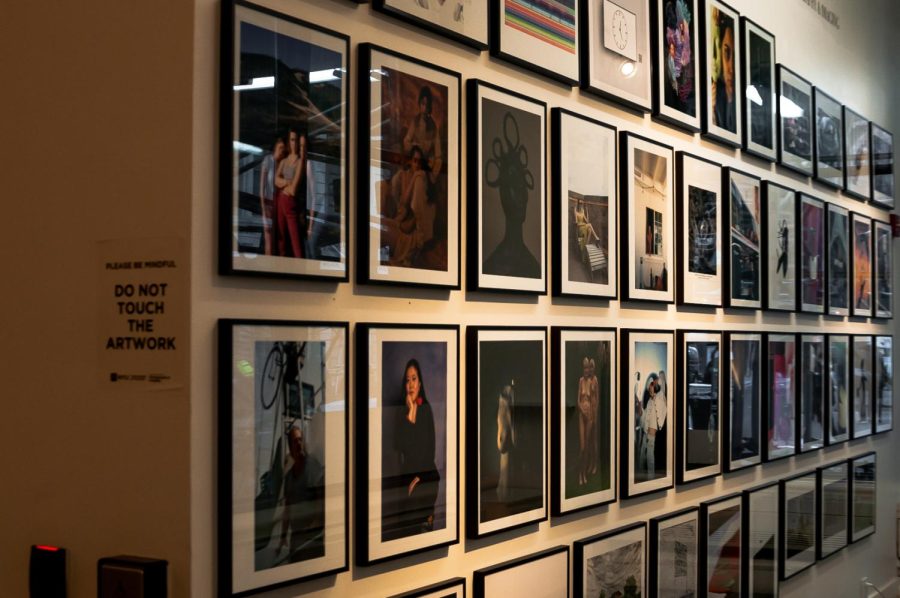Photography and multimedia series ‘Show One’ illuminates prevalent themes in modern culture
From the Photography & Imaging department class of 2022, “Show One” displays works that cover themes prevalent in modern society through a variety of artistic mediums.
“Show One,” a gallery in the Photography and Imaging department at the Tisch School of the Arts, showcases photographic and multimedia presentations by members of the program’s class of 2022. (Photo by Kiran Komanduri)
March 2, 2022
“Show One” is the first in this year’s series of photography and multimedia showcases by the Photography & Imaging department at the Tisch School of the Arts. Pieced together by photo department students and faculty, the gallery showcases a variety of photographic and multimedia presentations by members of the graduating class of the photography and imaging program.
The show, comprising 22 separate projects, opened to the public on Feb. 7, and runs until March 18. It is located on the first and eighth floors of 721 Broadway and can be visited from 9 a.m. to 10 p.m.
First-year Gaia Gamboa, a patron to the exhibit, walked in unsure of what to expect.
When she saw the first few artworks, the striking originality of the projects became clear. “I was very intrigued by the different types of works the exhibit had,” Gamboa said.
Show One covers themes ranging from mental health to privilege and gun accessibility in America. Ines Bu’s “Girlboss: Powerful and Empowered,” a project showcasing women of all body types perfectly framed in strong stances, will leave all viewers feeling empowered given its commitment to showcasing a diversity of body types through the lens of beauty. Bu’s work challenges traditional notions of beauty, working against the typical way in which women are framed by photographers working in fashion or advertising.
Projects like Jiaqi Liu’s “The Clock,” Rhianydd Hylton’s “These Roots of Ours” and Elena Gutierrez’s “samplespls_version2_new3.als” make use of multiple mediums to create a more immersive gallery experience. In Liu’s work, visitors scan a QR code that takes them to an interactive website with written blurbs about the passage of time accompanied by a ticking clock. Hylton’s piece features striking clothing items such as a dress with Black women’s hair woven into the hem alongside a series of photographs of the hairstyles. “samplespls_version2_new3.als” even showcases touching videos and samples of music to which you can listen to with headphones. No matter the format, the works have lingering effects, entrancing the viewer the longer they watch or listen. They are a testament to the malleability of photography as an ever-evolving art-form spearheaded by artists who have learned to think beyond simply taking pictures.
While the final projects are phenomenal on their own merits, Layton Davis, creator of “Designing Negatives,” emphasized that the most important part of the work to him was the process that preceded it.
Davis combines photographs of architectural pieces and edits them to add digital flare and a variety of colors to otherwise conventional pieces. For many of these young artists, designing the work wasn’t a linear process. It was the creative detours and experimentation while putting together their pieces that made the final products worthwhile.
“I am able to see the summation of my past four years in New York all concisely represented on one 16-foot wall,” Davis said. “I think that is when the work qualitatively means the most to me.”
Though all were visually appealing, an important aspect of the project was each photographer’s separate artistic theses which can be found in the written statements alongside each of the pieces. Emily Contreras Gómez, the artist behind “GAME OVER,” created a video of a single character running through “Battlefield-style” while a voice-over discusses the relationships behind the members of the video gaming community.
In her work, Contreras Gómez details romantic relationships between players of various video games to describe the connectedness people feel despite being far apart from one another. Highlighting the stories of two couples, Gómez was able to explore personal anxieties relating to relationships that she identified while putting “GAME OVER” together.
The works in “Show One” are typically experienced as elements of a single wall in 721 Broadway, but Jeff Thomas, creator of “Bull in a China Shop” goes the extra mile by really working to immerse viewers into his work. In a section of the eighth floor gallery, visitors can duck behind a curtain to see Thomas’ piece, which integrates multiple artistic mediums to depict coping with mental illness.
Using red as a central motif, Thomas uses a collection of sculptures, blood-splattered photographs and the simple setup of a white-walled room containing a small window, shelf and door to visualize how entrapped people can become in their own psyches. Viewers of “Bull in a China Stop,” confined to an enclosed space, are forced to feel claustrophobia, as they are physically given very little room to escape Thomas’ assaulting artwork.
Daniel Kyungjun Kim highlights the power of privilege in U.S. culture in his collection “Made in America.” Kim displays a pair of heels with nails in it to accentuate the danger wealthy Americans who wear name-brand heels carry with every step they take.
NYU alum Wyatt Humphreys uses a similar technique in “American Framework: An Unbrainwashing.” Humphreys’ work possesses a more striking feel than Kim’s. Its use of blood-stained photographs featuring people holding firearms creates a searing commentary on gun control in America. Humphreys hones in on the death that weaponry can cause us.
The heavy topics covered by many of the students on display at “Show One” demonstrates it is the photographic skills these students possess that makes their pieces shine. The careful placement of objects and specific lighting techniques employed by the artists bring life to the objects they capture, making you feel as though they are right in front of you.
Whether you choose to drop by between classes or spend hours taking a long walk through the galleries, “Show One” is a must-see.
Contact Bryn Borzillo at [email protected].
























































































































































